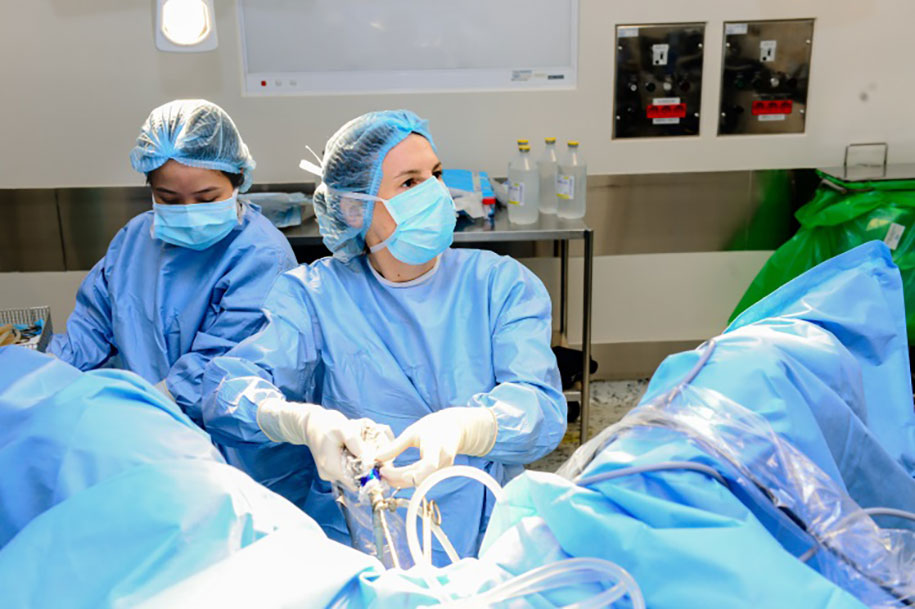Cervical cancer is one of the most common gynaecological cancers in women, and has vague initial symptoms. However, this disease can be treated successfully when detected in early stages.
According to the World Health Organisation (WHO), in Vietnam it is estimated that there are 20 cases of cervical cancer, 11 of which result in death, for every 100,000 women. All women are at risk of developing cervical cancer when they start engaging in sexual intercourse.

The earlier the treatment, the higher the success rate
In July 2020, Mrs N.T.T.H. (living in Binh Duong province) noticed abnormal vaginal bleeding but thought it was a sign of pre-menopause. Through examination and testing at a local clinic and a maternity hospital in Ho Chi Minh City, doctors concluded that she had cervical cancer with invasive cancer cells and advised her to go to the hospital for surgery.
Without hesitation, Mrs H. went to FV Hospital for treatment where she consulted with Dr Sophie Sanguin, a specialist in obstetrics and gynaecology, who indicated Mrs H. have pelvic MRI scan so that the stage of her cancer could be evaluated. Mrs H.’s cancer was an early stage cancer caused by the HPV 18 virus.
Through multidisciplinary meetings with oncologists at FV, Dr Sophie decided to use laparoscopic surgery to treat this case.
“Endoscopic lymphadenectomy is a rather difficult technique, requiring such specialist surgical skills that currently only a only a few hospitals in Vietnam deploy it, including FV. However, this method has many advantages: it is less invasive and enables patients to recover more quickly after surgery,” Dr Sophie explains.
Ten days later (September 15), Mrs H. underwent a three-hour surgery via endoscopy to remove her uterus, with two appendages and a pelvic lymphadenectomy. Doctors also conduct pathology in these organs to decide the next treatment plan.
After the surgery, the endoscopic surgical wound healed quickly and so Mrs H. was discharged earlier than expected. On October 2, Mrs H. had a follow up post-operation examination. Her doctors announced that her pathology results from the samples taken during surgery determined that there was no metastasis.
Currently, Mrs H. is living and working normally as if she had never undergone surgery.
“If I have a cancer, I have to be treated. Sadness can’t solve anything, I just have to go ahead with the treatment,” Mrs H. says, adding she felt optimistic about her chances when she first learned that she had the disease.
Dr Sophie Sanguin said that because many women came to FV Hospital when the disease is in a severe stage, the surgical efficiency is low because the tumour is much invasive, even metastatic. In this case it is necessary to apply treatment via polynomial therapy combined with chemotherapy and radiation.
How to prevent this disease?
Cervical cancer is a slow progressing cancer usually caused by the HPV virus, which is spread through sex. The danger is that early signs of cervical cancer are very vague, with almost no symptoms.
HPV is a group of viruses of which there are more than 100 different types, of which strains 16 and 18 are responsible for 70 per cent of cervical cancer cases. The rate of infection with this virus among women is also very high, with about 80 per cent of women at risk of getting HPV, of which the most susceptible age is 20 to 30 years old.
In addition, active and passive smoking, and unhealthy sexual lifestyles are also factors that can increase the risk of cervical cancer by two or three times.
According to the WHO, cancer detected in its early stages and treated promptly has a five-year relative survival rate of around 95 per cent. On the contrary, if the cancer is already at a late stage, when the cancer has spread into other areas of the body before being discovered, the five-year relative survival rate is only 10 per cent.
So what signs warn a woman that they are at risk for cervical cancer? Dr Sophie Sanguin says the characteristic sign is abnormal vaginal bleeding, especially after sexual intercourse, between menstrual cycles or after menopause.
To prevent cervical cancer, Dr Sophie recommends the HPV vaccine for girls aged nine to 26 years old who have not had sex.
In addition, women need to be periodically screened for cervical cancer with a Pap smear test (for women aged 20 to 30 years) or HPV test (for women aged 30 – 65 years). These methods detect abnormal and precancerous cells in the cervix so that women can receive early treatment with a high probability of success.
Women who have had cervical cancer need regular check-ups and screening. During the first five years after treatment, they should see their care provider for a follow up every four to six months. After five years, they need to schedule a follow up exam every five years until the end of their life.
Tuoi Tre Newspapers

 Vi
Vi 












